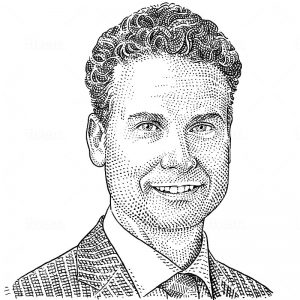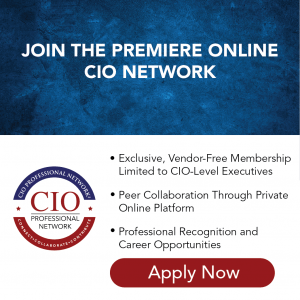Chief Information Officer of Dollar Bank, Bill Fortwangler, is no stranger to transformation and knows that change is only achieved by surrounding yourself with the right people. He began his career in technology nearly 35 years ago and today is an experienced CIO with a proven legacy in the financial services, manufacturing, and education industries. He was placed on the management track early in his career due to taking the initiative on projects and being a self-proclaimed impatient person. With his drive and work ethic, the path to CIO found him rather than the other way around.
We had the chance to chat with Bill and dive deeper into his experience transforming a legacy company. He also explained how he sees IT as a driver of culture change, how the CIO role has evolved in the past decade, and how he recruits top talent from his network.

Chief Information Officer
Dollar Bank
Walk us through your CIO path. How did you decide to pursue a career in technology, and how did you progress to your current organization?
I started my career in technology thirty-five years ago, basically because I wanted to be employed. I had aspired of being a rock star and or playing in the NFL and those types of things, (oh to be a dreaming teen again) but I never had a burning desire for technology. I just wanted to be gainfully employed.
I’ve always had a dominating personality. So, when I got my first job in technology, I started on a management track within a few years rather than staying as a developer and programmer. Career progression kept happening because I would take control of a situation or project. Being an impatient person, I would see things being done the wrong way or see inefficiencies that, selfishly, affected me and made me work harder than I needed to.
I never thought about aspiring to be a CIO until I was hired at a for profit education management company. During the interview process, the CIO that hired me mentioned that he would need a successor in a few years. I thought, well, everybody says that. In a few years, though, he did move on, and the business wanted me in that role when he left. It was a company that was sinking slowly, and he told me that I just needed to stomach this and wait it out, and it would get better.
Unfortunately, or fortunately, the previous four companies I worked for were either startups, where we didn’t know if we would have jobs in six months or were companies in decline. So, this company was no different, and I knew the recipe and what needed to be done. Companies in decline can be a very challenging but very rewarding experience. I was a CIO of retraction rather than growth.
After a couple of years, the opportunity at Dollar Bank came up, and I decided to go to a company that was profitable, stable, and willing to go into a massive progressive technology change. These types of fortunate opportunities seem to come up. The point is that you can take the easy way out, or you can accept the new challenges and the extra responsibility, knowing what you are getting yourself into.
What initiatives have you overseen to date with your current organization? What’s on the horizon?
When I got to Dollar Bank, I first needed to establish an outside pipeline with the technology community in Pittsburgh and the vendor community. Many legacy solutions were being handled internally, and we needed to hear from vendors about new products and services.
So, we started evaluating outsourcing specific solutions to cloud providers and decided to replace our consumer online banking platform. Internally, IT historically wanted to re-build it, but the business team wanted to go to a service provider that had the depth of feature functionality and future investment. So, we brought in a third-party arbitrator, and we ended up replacing it by outsourcing. We replaced much of our infrastructure and modernized our data center as well.
While we are slowly moving most of our solutions to service providers, we brought one service back in-house. We reviewed our outsourced branch support technology service and decided to hire our staff to go to our branches and fix the technology and equipment needing to be serviced. The branches embraced this; they liked that it was a Dollar Bank employee versus somebody from an outside company, and it was more efficient and less expensive.
We also formed a database administration group, a quality management team, and a project management office. The bank was growing at a pace that was outmaneuvering what the former IT organization was capable of. The modernization of IT and enabling regulatory compliance was a key driver to allow growth.
Within the last few years, we have been upgrading, replacing, and deprecating various infrastructure, networking, and application systems both internally and for our customer base. We are finally at a point to tackle our largest projects. We are in the infancy of completely replacing our core banking platform and some peripheral systems. We also moved our headquarters to a new building this year, which provided us with a great opportunity to overhaul our conference rooms and improve the audio/visual equipment.
The role has been all about transformation, not just changing IT but also getting the business to think differently and utilize digital signatures, video conferencing, and iterative delivery. We are changing how we conduct business internally so that our customers will also gain efficiencies in the products and services that we provide.
IT can be a driver of culture change. What changes have you seen in how employees do their work?
If we had not invested in various types of remote access two years before the pandemic, we would not have been able to enable remote work. Culturally, when I got here, we did not have a remote work policy. We immediately drafted one and got it approved and then updated our remote technical capabilities so that our employees could at least work from home a day or two. This was also a value add for the Business Continuity / Disaster recovery programs.
This helped retain talent, and in March 2020 when employees were told that, in a week, they would start to work 100% remotely, the business units were shocked that they were able to do so.
Remote work also creates a culture of trust. In that first month of the pandemic, I had a conversation with about how we measure people’s productivity, such as when employees log on in the morning. I said working from home should be no different.
Employees have their deliverables, and they’re either delivering or not. So, the mindset had to change to trust our teams. Measure on their output, not what time they clock in and out.
Speaking of talent, how do you find the right talent for your organization?
When I got to Dollar Bank, I brought in people I worked with at previous companies who would be a good fit for certain roles. Two of my hires I worked with in the late 80s, and those in my network have their networks too, so finding talent during this transformation was easy. Working for 9 different companies over the last 30 years builds a nice pond of talent to fish for. I’ve done a lot of repetitive hiring, my wife jokes that she can’t believe people would want to work with me a second time.
Now that we’re evolving, it is becoming more difficult for certain roles and situations. I will reach out to recruiting vendors that I have worked with for 25 years since they know exactly what I’m looking for. I also belong to technology groups in the Pittsburgh area, where I also mentor. With Pittsburgh being a small IT community, somebody knows somebody who knows somebody, so the reference angle works well for us.
I’m personally involved in the recruitment process because I can’t be close to the technology at my level, and sometimes that bothers me. So, I need to know that the people who are close to it are smarter than me. You’ve got to get the right people. You can have the greatest technologies in the world, but it’s all about the people who build run and maintain them. We have all seen that old system that does all it needs to do and more replaced by a poorly implemented, poorly configured system that should have been the next wonder of the world.
Another thing we practice is succession planning. We have meetings, at my level and above, every other month. We talk about how to get these people to the next level, what mentoring and formal trainings are needed, and if I get hit by “the train” who’s capable and ready to take over.
How is being a CIO today different compared to 10 years ago?
CIOs and IT should be more than just a service provider. We are driving this core banking transformation. As CIO, we’re a business partner, and we drive change. Moreover, all the digital channels and the operations have to be working 24/7. The business resiliency relies on Technology. The data protection relies on Technology. The enablement of being a business partner is very different than it has been in the past. The CIO should have a seat at the table and not just be talking “systems talk”. You as CIO better know the business needs and understand how to take your business there.
CIOs today need a well-rounded experience, from technology to business to emotional intelligence. The emotional intelligence is an equally important aspect. I’ve talked about this with my prospective replacements, suggesting they switch roles with others in the company before being selected as our next CIO.
What advice would you give to those who aspire to be a CIO?
I say this to those who I mentor: “Do you really want this?” I say this to my successors as well. It is constant stress and constant problem-solving. There’s rarely a day when everything’s just great. As CIO I still may be on an overnight call to ensure our services are available to our customers.
As CIO, you will have to interact with people and win over their confidences at every level. There’s always someone who isn’t going to be in your court. And when something goes wrong, you’re going to have to explain, in laymen’s terms, why it happened on your watch.
With that said, this job can be very rewarding, especially when so many people come together and resolve a problem. You’ve got to be able to talk to anyone in the organization. Everyone needs to have the opportunity to complain. You’ve got to be approachable. You are being watched constantly, from above and below, and everything you do is analyzed. But, most importantly, you’ve got to protect your people. Even as more automations are put in place, you still need skilled, talented, intelligent people.
What would you want our readers to know that we haven’t covered?
I like to have fun; work is not my primary thing. I like to golf, play the guitar, piddle around the house, explore dining, take care of the cat and dog, and entertain from our home.
That’s what I work for. It’s not all work, work, work. I go golfing and to other social events with my direct reports, and we need that time. Because of that time together, some of them have become lifelong friends.







